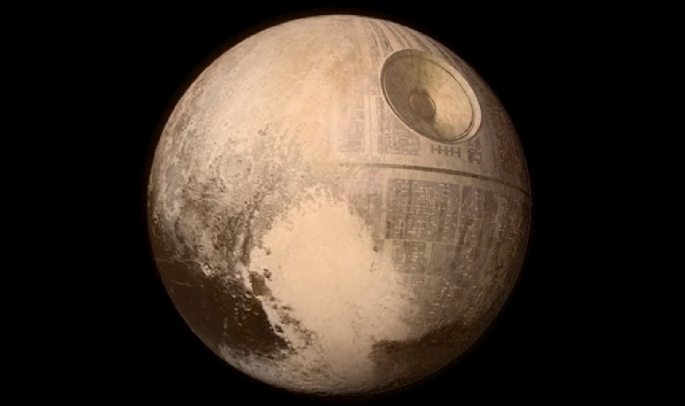Discovering Pluto
Curiosity Can Clear Up a Fuzzy Picture
We are very excited about the New Horizons spacecraft and the new information that is returning every day about Pluto. This newsletter is dedicated to Pluto!
Scientists driven to explain disturbances in the orbit of Uranus had been searching for information about “Planet X” since the late 19th century.
Pluto was finally discovered in 1930 by the late Clyde Tombaugh, although from the beginning, Pluto has been misunderstood, and discrepancies cast doubt on the idea that it was truly the “missing” planet disturbing Uranus’s orbit. Through the years, estimates of Pluto’s mass continually changed with the on going collection of better data. To start scientists estimated the mass of Pluto to be the same as Earth, now we think its 0.002 the mass of Earth. The planet Pluto was, with some controversy, downgraded to the status of “dwarf planet” in 2006. The debate on the title of planet or dwarf planet rages on to this day.
Curiosity about Pluto has been high since its discovery. And after 85 years of waiting, a spacecraft flew by Pluto this week! This interplanetary space probe was launched back in 2006, was launched at record speeds and is currently travelling at 14.5 km/s (52,000 km/hr), which is slightly faster than a drive to the cottage on a summer weekend.
On its journey, the spacecraft has flown by Mars, an asteroid, and Jupiter. On Tuesday July 14, after nine and a half years, it finally reached Pluto and its five known moons.
The New Horizons mission will help answer questions about Pluto‘s formation and the composition of its atmosphere and surface. How interesting that one of the first pictures of Pluto to come back from spacecraft cameras showed Pluto has a “heart” – an oddly patterned band of geological features in the southern hemisphere. New pictures from yesterday showed “young” mountain ranges and amazingly no evidence of impact craters. From the initial data which provided a “fuzzy” picture to New Horizons data which will stream to Earth over the next few weeks and months, we will all better understand this celestial body.
We are curious to see more of Pluto, however, we hope the first detailed images of Pluto do not look like this:

Luckily Earth isn’t part of a Rebel Alliance. But seriously, we won’t know detailed information about Pluto until late in 2016 due to limited bandwidth.
From the first inkling of its potential existence well over 100 years ago to the high resolution data expected to be received by next year, our understanding of Pluto continues to become much clearer, all due to the boundless curiosity of our species.
Our work in the environmental sector is often driven by a similar curiosity to explore and understand the unknowns through better data collection and interpretation.
Similarly to NASA engineers, environmental practitioners use suitable force to deploy probes to the furthest reaches of the unknown (subsurface). Data is then retrieved (field readings or laboratory analysis) for interpretation and analysis. At first the picture is usually fuzzy. With more and better quality data, we are then able to create a clearer, more refined picture of what this particular subsurface world looks like.
Continuous advancement of knowledge and technologies, enables NASA to push the limits of our understanding of the formation and structure of our universe.
Continuous advancement of knowledge and remediation technologies enables our industry to push the limits of our understanding in order to affect positive changes to our environment.
Here at Vertex, we are very curious of our natural world, whether it be the surface of Pluto or the subsurface of Earth. We will keep you posted on developments as we continue to search for new and better ways to explore and understand the unknowns of our natural world.

